| Easiclene Easiclene was founded at Wembley, London, in 1935
under the name Easiclene Porcelain-Enamel Limited. Three
years later it went into liquidation and was purchased
by Rubery Owen, and re-registered as Easiclene
Porcelain-Enamel (1938) Limited.
The original factory
closed in July 1947, and production moved to Darlaston.
The head office was in Lord Street, Wolverhampton. Easiclene products were manufactured in
part of the Vitreous Enamelling Department.
Easiclene specialised in the manufacture of domestic
equipment, built to high standards. Products included
kitchen sink units, kitchen cabinets, wash basins, enamelled table covers, lavatory
flushing cisterns, draining boards, washing machines,
and refrigerators. |
|
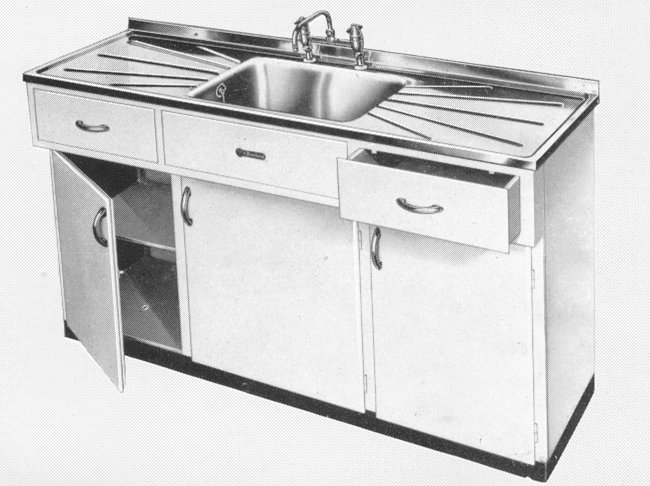
An Easiclene sink unit. |
|
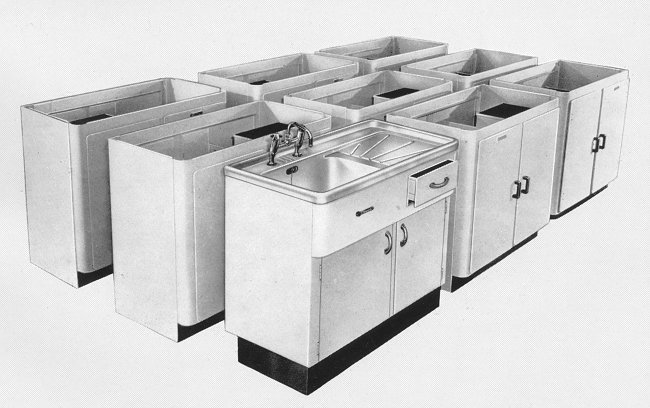
An Easiclene sink unit and
cupboards. |
|
The company continuously carried
out extensive research into the design, manufacture, and
general application of its products in the modern home,
which successfully combined labour saving features with
an attractive appearance.
The products were made available to
housing authorities, architects and builders, and to the
general public through leading builders' merchants, and
stores, throughout the country.
The well known 'Princess' range of
sink units and cabinets also included draining boards,
lavatory wash basins, and flushing cisterns, finished in
pastel colours of vitreous enamel to withstand hard wear
and rust. The 'Duchess' range of sink units and
washbasins were also manufactured in various sizes, in
mirror finish stainless steel. |
|
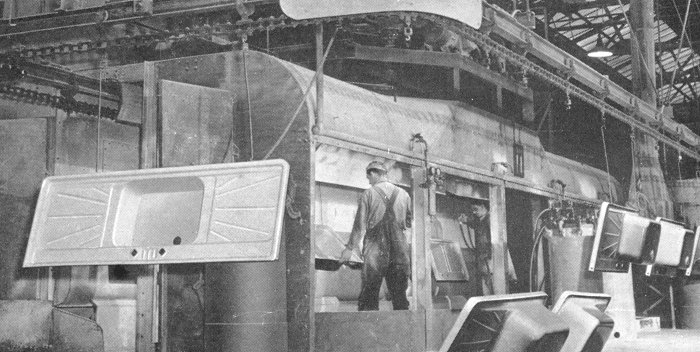
Spraying a coat of gloss
enamel on sink units, prior to fusing in a vitreous
enamelling furnace. |
|
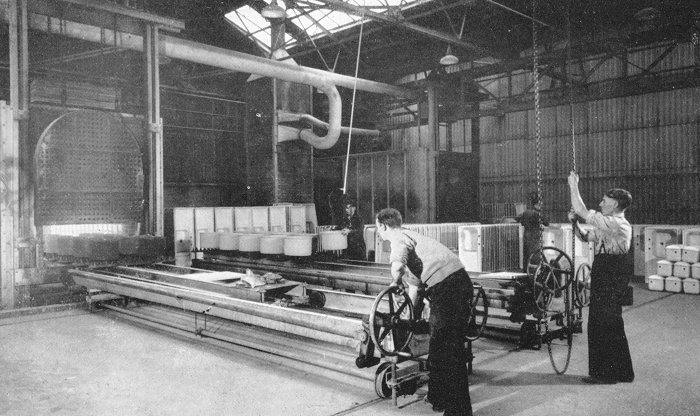
Loading the furnace. |
|
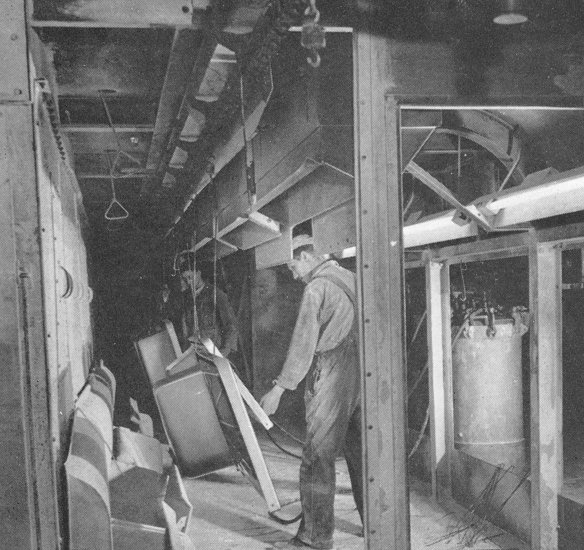
Part of the vitreous enamel plant. |
|
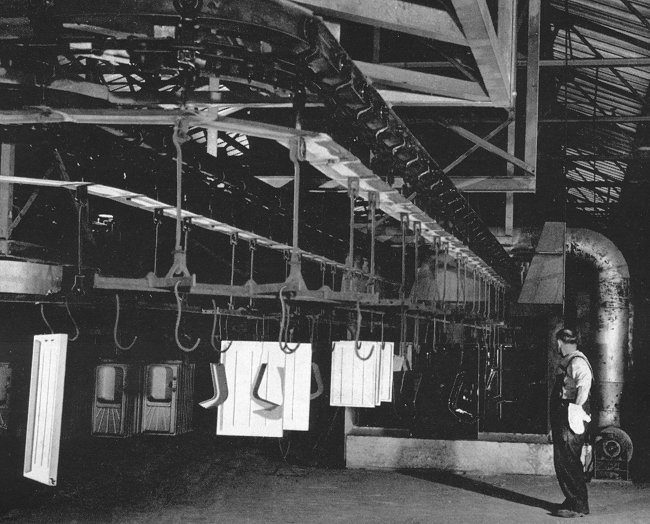
The fusing plant in the Vitreous
Enamelling Department. |
| During the Second World War, the company
manufactured refrigeration cabinets, Soyer stoves, and
field kitchens to Admiralty and Ministry of Supply
specifications. The products were extremely successful.
During the war there was a fivefold increase in production. |

The Easiclene display
lorry. From the autumn 1954 edition of the
staff magazine "Goodwill". |
|
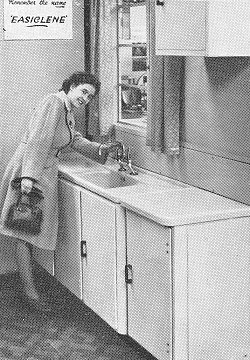 |

From the Christmas 1948 edition of the
staff magazine "Goodwill".
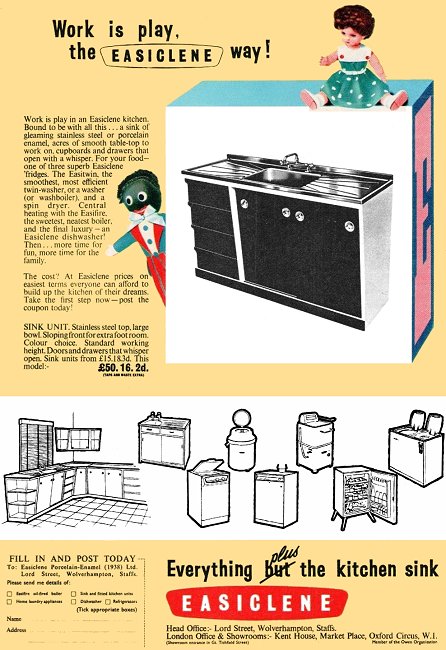
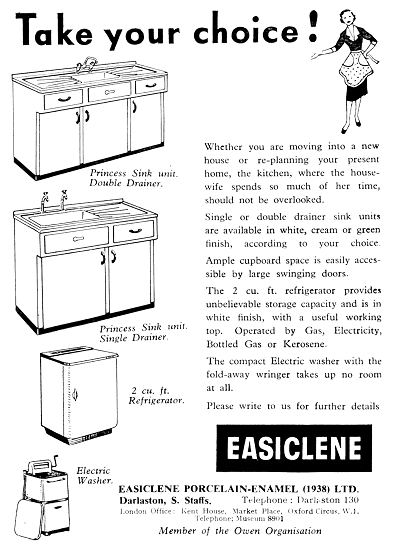 |
 |
|
Two adverts from the mid 1950s.
Courtesy of Christine and John Ashmore. |
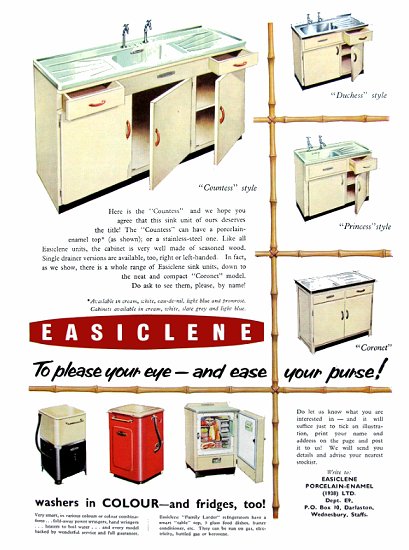
|
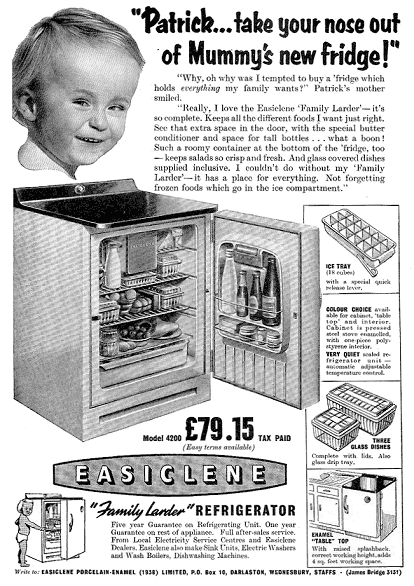
From Ideal Home magazine, May
1957. |
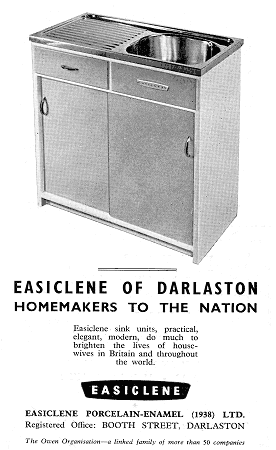
An advert from 1963. |
 |
An advert from 1964. By
this time the company's office was at 21b Woden
Road, Wolverhampton. |
|
At the time of the Munich crisis, it
seemed that war was inevitable, and Mr. A. G. B. Owen
realised that factories would be potential targets for
the enemy.
In such circumstances, efficient fire
fighting would be essential to minimise damage, and so
he formed the Rubery Owen Works Fire Brigade.
The original brigade had a
complement of fourteen men, with Mr. H. C. Harris (known
as Skipper) in command.
He had previously gained
considerable fire-fighting experience in the Merchant
Navy, and so was ideal as the brigade’s first Chief
Officer.
With the continued threat to the factory in the
early war years, from the German bombing campaign, and
the liberal use of incendiaries, the brigade grew to one
hundred and twenty part-time members, and the
appointment of Mr. E. Hoggart, previously from the
Nelson Borough Fire Brigade, as full-time Second
Officer. |
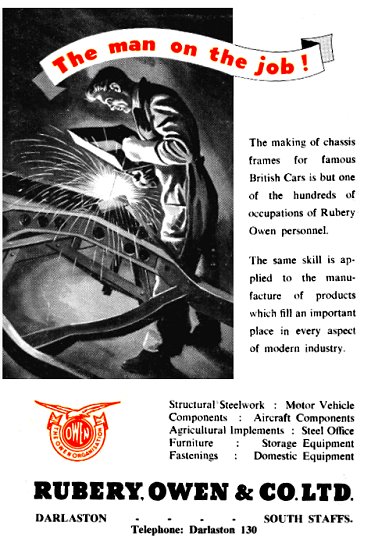
An advert from the mid 1950s. Courtesy of
Christine and John Ashmore. |
|

The fire brigade and some of their
trophies. From the staff magazine, Christmas
1947. |
| The works fire team who took
part in the annual competition at Brymbo Limited, North
Wales, which took place on 10th September, 1949.
They won two out of the four
events, the hydrant drill, and the light pump drill.
They also won the Aggregate Trophy for the highest
number of points.
From the autumn 1949 edition of
the staff magazine "Goodwill". |
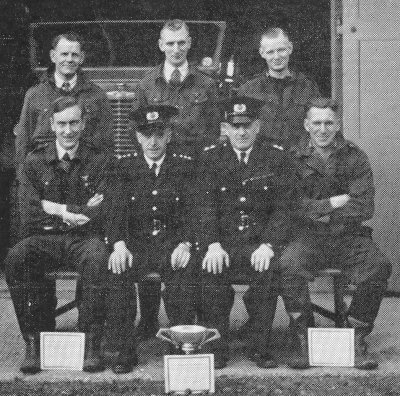 |
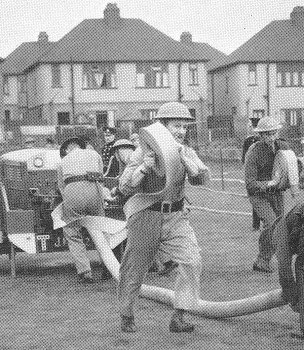
The fire brigade competition team
in action. From the staff magazine, Christmas
1947. |
A new brigade headquarters was
built in a central position, alongside the canal,
offering a more than adequate supply of water. It was
fitted with up-to-date equipment, and accommodation for
a shift of fifteen men, who would be on duty during the
long wartime nights.
Thanks to the high standard of
training, the brigade had many successes in competitions
organised for industrial fire brigades, and acquired a
large collection of cups and trophies.
One of their spectacular successes
occurred in 1944 when they won the prestigious light
trailer pump competition at the Regional Headquarters of
the London Fire Brigade, at Albert Embankment, London.
Another important team was set up
around the same time. In October 1938 discussions began
on the formation of the Works Ambulance Division, which
also played an important role during the war.
|
| The team were selected from volunteers who were
trained in the necessary first aid skills. Throughout
the war, some members also undertook ARP duties at the
works and for local authorities. Unfortunately the
first Ambulance Officer, Mr. Farmer who was the late
night superintendent, passed away in 1941 after a long
illness. Five team members entered various ARP
competitions and gained several awards. They were J.
Perry and H. Martin from the General Office, J. Turner
and P. Marsden from the Motor Frames Tool Room, and C. Newey. After the war, the Division was reorganised so
that first aid equipment was available in all
departments, and in the offices, in case of major
accidents. Volunteers were asked to join a scheme
which ensured that each department had at least one
ambulance man. Division meetings were held at the First
Aid Headquarters on Thursday evenings between 5pm
and 6pm. |
|

The Rubery Owen Home Guard Brass
Band, in 1940 or 1941.
Back row left to
right: Jim Badderley, Joe Ratcliffe,?,Jack
Jenkins, Frank Jellyman,?,?,?
Middle row left to right: ?, Mansell,?,?, Les
Emery, Phil Wright,?
Front row left to right: ?,?,?, Harry Lowe, Mr.
Page, ?,?, Harry Wright
Seated on the ground: Michael ?,? |
|
|
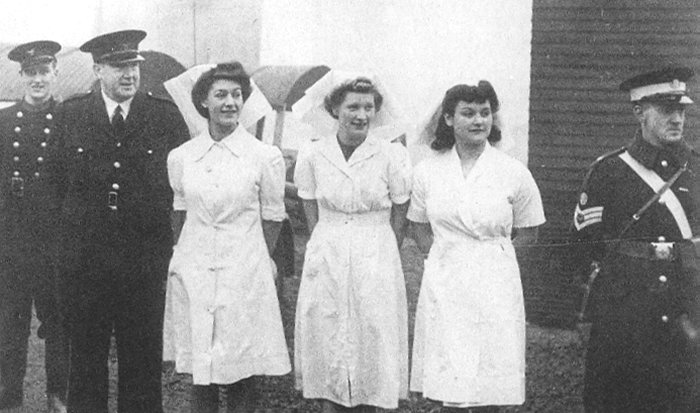
Firemen, Nurses and Ambulance
Division staff in 1943. |
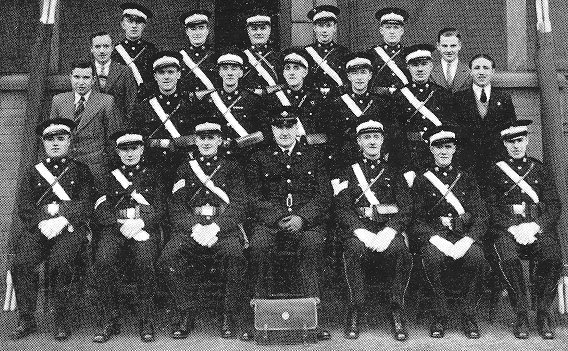
The Ambulance Division. From the spring
1947 edition of the staff magazine "Goodwill".
|
During World War II the company turned out all kinds
of products to assist in the war effort, including wing
flaps, ailerons and tail units for Lancaster bombers,
parts for the De Havilland Mosquito, aircraft propeller
hubs, aircraft wings, lifeboats, sea mines, bombs,
armoured car bodies, Bofors guns and howitzers, Bailey
bridges, 'jerricans', and even large quantities of steel
helmets.
In January 1943, the Duke and
Duchess of Gloucester paid a visit to the Darlaston
factory, as did Sir Stafford Cripps, Minister of
Aircraft Production, in February, 1944.
In order to fulfil orders for the Admiralty,
the Warrington company's engineering department was
turned into a separate company. By the end of the war
the firm employed around 16,000 people and the future
for peacetime products looked extremely bright. In
1946 the product range included components for horse-drawn vehicles, dry element air
cleaners, metal pressings, fasteners, motor vehicle components,
and structural steel components for the building
industry.
In the same year, Rubery Owen Messier Limited, which designed and
manufactured hydraulic and electro-hydraulic equipment for
aircraft and industrial applications, were producing the Conveyancer
forklift truck, claimed to be the first
forklift truck made in the UK.
|
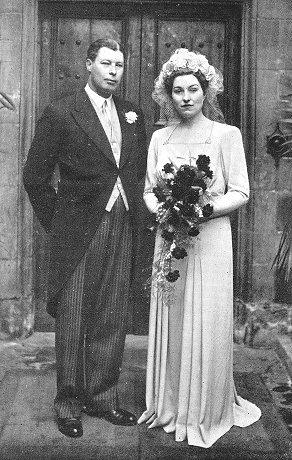
Ernest W. B. Owen and Patricia
O'Reilly of Belfast were married on 26th February, 1947
at the Parish Church, Sutton Coldfield. From the spring
1947 edition of the staff magazine "Goodwill". |
| Sir Alfred George
Beech Owen Alfred George
Beech Owen (1909–1975) was the son of Alfred Ernest Owen
from Wrexham. He was educated at Emmanuel College,
Cambridge and after the death of his father in 1929 he became
joint managing director of Rubery Owen with his brother
Ernest William Beech Owen.
He was a lay preacher for much of
his life, and proprietor of the BRM motor racing team
from the early 1950s to 1974, and in 1963 received the Ferodo
trophy as the man who had done the most for British car
racing.
He served on Darlaston Urban
District Council from 1934 until 1966 when it was
absorbed into Walsall County Borough, becoming Chairman
from 1942 until 1946, and again from 1952 until 1954.
After the merger he continued to represent Bentley ward
until 1972, and was also a councillor in the Borough of
Sutton Coldfield from 1937 until 1974, becoming Mayor in
1951.
He was an independent member of the
Staffordshire County Council from 1949 until 1966,
serving as Chairman from 1955 until 1962. |
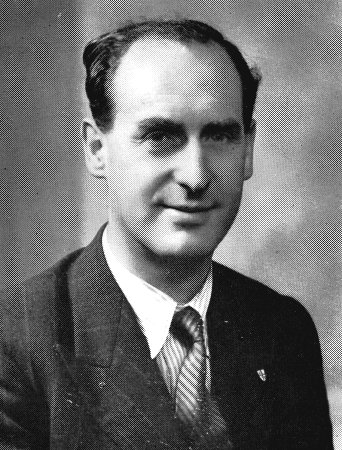
From the Christmas 1948 edition of the
staff magazine "Goodwill". |
|
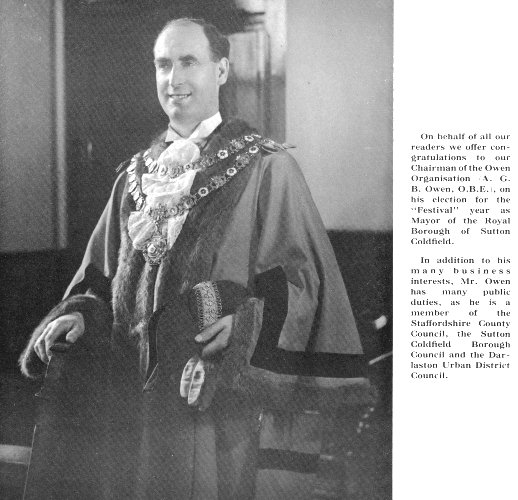
From the autumn 1951 edition of
the staff magazine "Goodwill". |
Sir Alfred had been made an O.B.E.
in 1946, and a C.B.E. in 1954. He was appointed Knight
Bachelor in 1961 for services to local government.
After retiring as chief executive
of all the companies in the organisation, he remained Chairman of Rubery
Owen Holdings Limited until his death on 29th October, 1975.
He served Keele University from
1957, first as Chairman of the Council, then as Vice President of the
University College of North Staffordshire. When it received
a full Charter he became Pro-Chancellor, and was made an
Honorary D.Sc. in 1965. |
|
He also served on the Council of
Birmingham University, and on a number of national
committees including Dr Barnardo's, the Boys
Brigade, and the Youth for Christ Movement. He was also closely
associated with the Billy Graham Crusades, and served as
Vice Chairman of the National Savings Movement, and
Chairman of the National Road Safety Council.
Six years after the death of his
mother in 1958, he took up residence in the family's
home, New Hall Manor estate in Sutton Coldfield, where
he lived for the remainder of his life. In 1970 he was
made Freeman of the Borough of Sutton Coldfield, the
last person to hold the office.
Convalescent Home |
| A large number of Rubery Owen employees had
participated in the Second World War. When peace
returned, consideration was given to the erection of a
memorial tablet, or a cenotaph, to commemorate those who
had lost their lives. It was thought that a better way
of recognising their important sacrifice was to open a
staff convalescent home in their honour. At the
beginning of 1946 the search for a suitable property
began, and soon ended with the discovery and purchase of
'Cadogen'. |

The Owen Group Convalescent Home 'Cadogan'
at Dyffryn, North Wales. From the spring 1947 edition of
the staff magazine "Goodwill". |
| The house was ideally suited for the purpose in
hand, standing on the Welsh coast about halfway between
Harlech and Barmouth, overlooking Cardigan Bay. The
nearby railway station made travel easy, and the
location, below the Welsh mountains to the east, had a
mild climate. The beach, with several miles of good
sand, only a few minutes' walk away, was ideal for
visitors. There were wonderful views across the bay, and
to the mountains, and a reliable bus service from the
nearby village of Dyffryn to Harlech and Barmouth. |

A view of 'Cadogan' from 1960
showing the new extension. From Histories of Famous
Firms - Midlands Survey part one, 1960. |
The house had ten bedrooms on the two upper floors,
each with two or three single beds, wardrobes, chairs
and a rug for each person.
There were two separate bathrooms, one for men and
one for women, dining rooms, games rooms with a
billiards table, dart boards, and facilities for playing
draughts or dominoes. The lounge had a piano, a
radiogram, books and periodicals so that visitors could
feel at home. |
| There were both inside and outside toilets, and a
beautiful kitchen garden, lawns, and fruit trees
covering about an acre. |
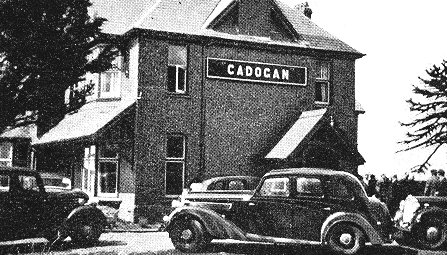
Another view of 'Cadogan'.
From the summer 1947 edition of
the staff magazine "Pyramid". |
In order to be admitted, staff had to get their
doctor's signature on a form which could be obtained
from the company's Welfare Office.
The rail fare to and
from the house was paid by the company.
It was found
that the health of visitors soon improved, and often
they could be back at work after only a few days stay at
the home. |
|
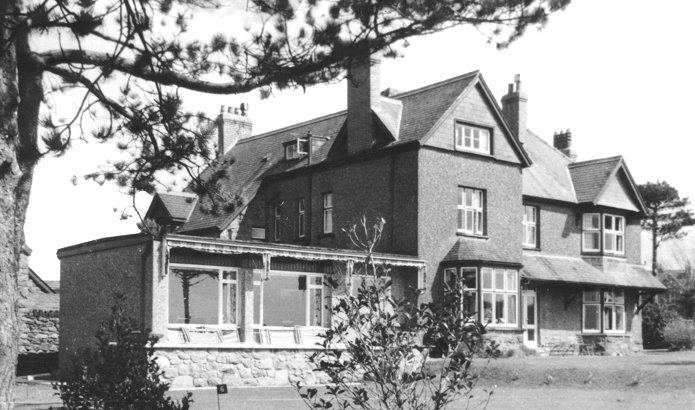
A final view of 'Cadogan'.
From an old postcard. |
|
The official opening took place on Wednesday 25th
September, 1946 and some time later a plaque was
unveiled at the house to commemorate the employees who
lost their lives in the war.
The Day Nursery |
|
In order to cater for the many working mothers at
the Darlaston factory, the company opened a day nursery,
supervised by a matron and several nurses who looked
after their young children. Orange juice
was supplied every day at 11 o'clock as part of the
Welfare Foods Scheme, and adequate toys were provided
along with excellent supervision.
The matron was Miss H. M. Tilley. |
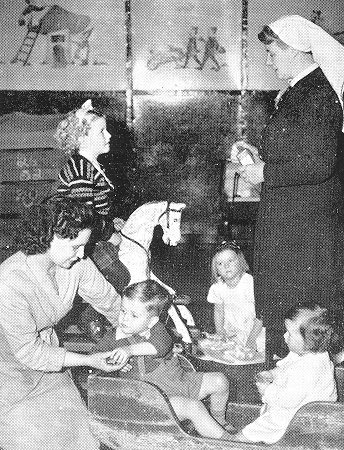
The Day Nursery. From the spring
1950 edition of the staff magazine "Goodwill". |
 |
Another view of the Day
Nursery. From
Histories of Famous Firms - Midlands Survey part
one, 1960. |
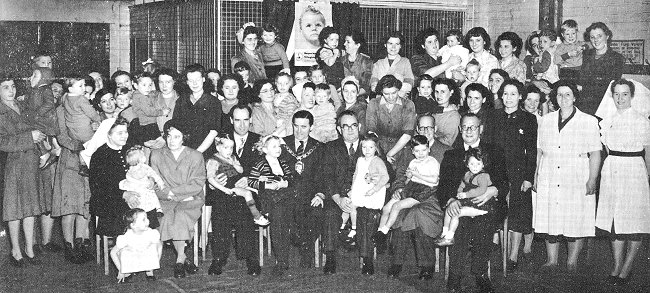
The welfare foods publicity
meeting that was held in the hall adjoining the
nursery on 3rd November, 1949. Seated Left to Right:
Miss H. M. Tilley (matron), Dr. E. P. MacWhirter
(Medical Officer of Health), Mr. A. G. B. Owen,
Councillor Harmar Nicholls, J.P. (Chairman of
Darlaston U.D.C.), Dr. V. V. Brown (Works Medical
Officer), Rev. R. S. Phillips (Rector of Darlaston),
and Mr. F. B. Jones (Food Executive Officer
for Darlaston). From the spring 1950 edition of the
staff magazine "Goodwill".
|
| The Childrens'
Christmas Party Christmas parties were held
in the main works canteen in Booth Street for
employees' children up to twelve years of age.
Several sessions would be held to cater for the
large number of children, who were given presents,
apples and buns, and entertained with a Christmas
Eve show.
The parties were run by members of the Benevolent
Committee, the canteen staff, St. John's ambulance
men, and works' police. |
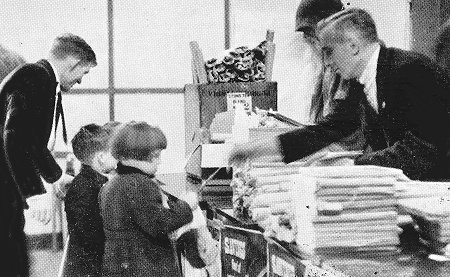
Father Christmas handing out
Christmas presents. From the spring 1947 edition of
the staff magazine "Goodwill". |
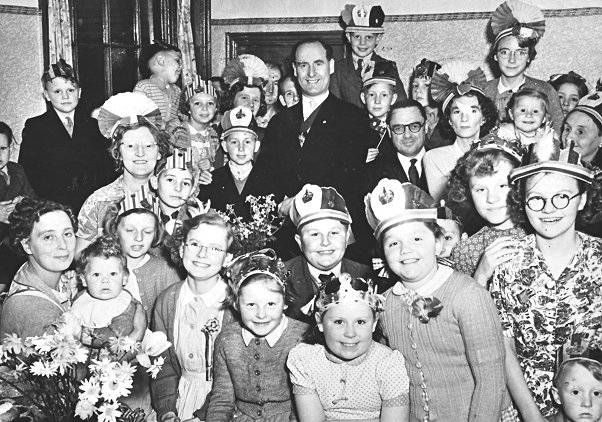
A. G. B. Owen at a children's
party to celebrate the Coronation in 1953. From the
collection of the late Howard Madley. |
|
Rubery Owen Kepston Limited |
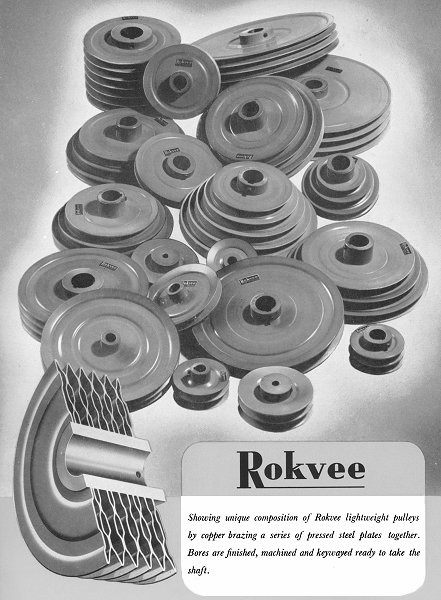 |
In the early part of 1950,
Rubery Owen Kepston Limited began producing the 'Rokvee'
range of pressed steel vee belt pulleys at the
Darlaston site.
The unique pulleys consisted of
pressed steel plates, copper brazed onto a machined
boss, to produce an indestructible, lightweight
pulley, capable of much higher running speeds than
conventional cast iron pulleys.
The whole pulley assembly was
heated to a temperature of over 1,100 degrees
Centigrade in an artificial atmosphere, and cooled in a
manner that ensured that the components would remain
undistorted and true to within 0.003 of an inch, of
their original shape.
They were available in a range
of sizes, up to 18 inches in diameter. |
|
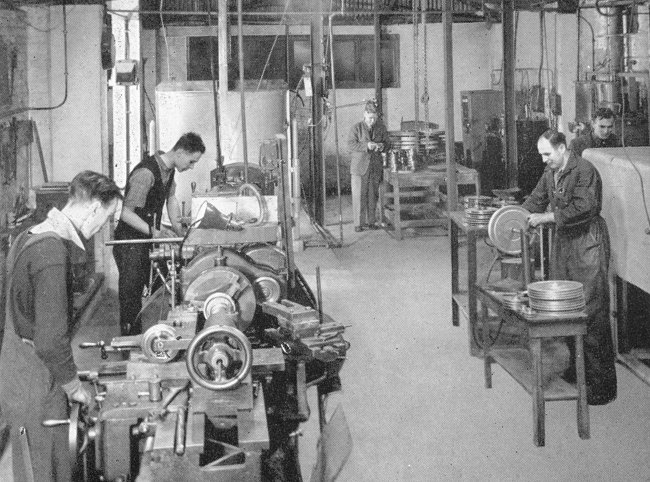
Trueing the pulleys, after
brazing. |
|
Special copper brazing furnaces
were developed, that did not use heat-resisting
steel, which had become acutely short due to the
demands of Atomic Energy experiments.
The furnaces were capable of
copper brazing assemblies of almost any shape or
size. 'Rokvee' pulleys were an important development
in the field of power transmission.
Their concave grooves conformed
to the convex flexing of a vee belt, which gave even
wear to the belt, and a far greater tractive force
than a normal turned pulley. |

Assembled pulley components,
about to be placed in a mobile furnace for copper
brazing. |

The company's float that
took part in the 1953 coronation festivities.
Courtesy of Raymond Chew and Stephen Flavell.
The lady on the left is Sheila Chew, Raymond's
mother. |
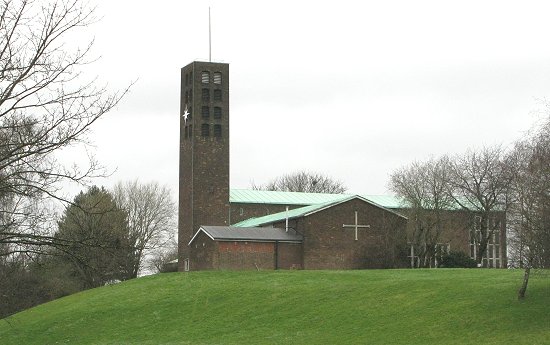 |
In 1954 the Owen family built the
Emmanuel Church, Cairn Drive, Bentley, Walsall as a
memorial to Alfred Ernest Owen.
The Emmanuel Church Bentley in
2014.
|
| The commemorative stone plaque
on the church. |
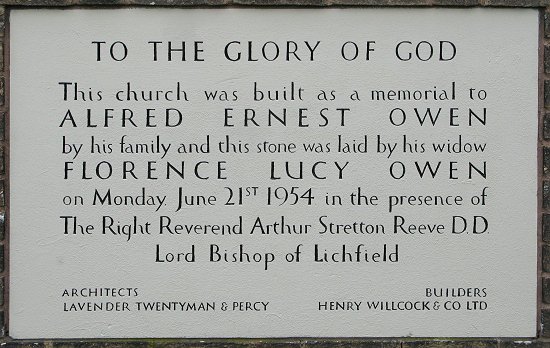 |
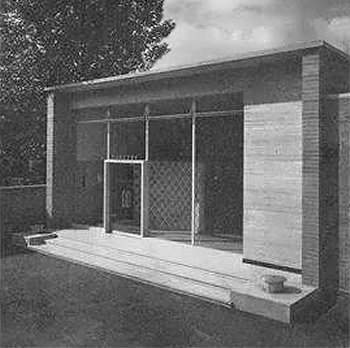 |
The surgery building on the Darlaston site was built in 1953
and designed so that patients could easily enter the
building, even when carried on a stretcher, via the wide front door and
a rear door, without any awkward manoeuvring.The doctor's consulting room was placed opposite the injury room and
had direct access to male and female dressing rooms, each with its
own toilet.
The architect was Leonard J. Multon.
The surgery building. |
| The medical staff consisted of a doctor, a sister, and assistant
nurses. They treated around 250 patients a day.
There was a separate
injury room where first aid was given to patients with
a severe injury before they were taken to hospital. As well as
dealing with injuries they undertook after-care treatment and the
prevention of occupational diseases.
Part of the Foyer.
|
 |
|

The interior of the surgery. From
Histories of Famous Firms - Midlands Survey part one, 1960. |
There were excellent medical facilities on hand for the
staff, including an
ophthalmic clinic, and a dental surgery, both of which opened in
1959. They were fully equipped, and operated under the
National Health Service. They were run by a qualified doctor
and nursing staff, and were available to all employees. |
| Rubery Owen also had its own savings bank, and the
employees were actively encouraged to build-up their
savings. By 1947 the employees between them, were saving
around £1,210 per week, which works out at 4 shillings and
ten pence per employee. |

A letterhead from 1947.

Another letterhead, also from 1947.

'Mars', the company's industrial locomotive
that ran on the internal railway. As seen on 20th August, 1966.
 |
|
 |
|
 |
Return to
Expansion |
|
Return to
the contents |
|
Proceed to Later Years |
|